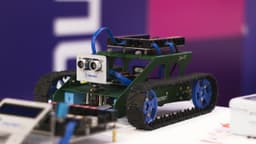Is Cutting-Edge AI Limited by Hardware Costs in 2025?
The dream of running powerful, open-source artificial intelligence on your own hardware is rapidly moving from niche fantasy to tangible reality. However, this dream comes with a significant price tag. As developers, researchers, and enthusiasts look to harness the capabilities of cutting-edge large language models (LLMs) like OpenAI's gpt-oss-120b and Meta's ambitious Llama 4 series, the central question becomes: what is the real cost of the hardware needed to power them locally?
Running models locally offers compelling advantages: absolute data privacy, freedom from API fees, lower latency, and the ability to fine-tune and customize models for specific tasks. But these benefits are gated by a critical hardware bottleneck: Graphics Processing Unit (GPU) VRAM. This specialized video memory is what holds the model's parameters, and if you don't have enough, you simply can't run the model. The cost, therefore, is not just about processing speed, but about memory capacity.
The New "Entry Level" for Titans: Running 100B+ Parameter Models
Not long ago, running a model with over 100 billion parameters was exclusive to hyperscale data centers. A recent breakthrough has changed that: quantization. This process reduces the numerical precision of a model's parameters (its "weights"), shrinking its memory footprint dramatically without a catastrophic loss in performance. Instead of using 16-bit floating point (FP16) numbers, models can use 8-bit integers (INT8) or even more compact 4-bit formats like MXFP4.
OpenAI’s gpt-oss-120b, a 120-billion parameter model, is a prime example of this optimization. Its native support for the MXFP4 format allows it to fit onto a single GPU with 80GB of VRAM. This brings two key enterprise-grade cards into focus:
- NVIDIA H100 (80GB): The undisputed industry standard for AI. An H100 is a powerhouse of computation, but this power comes at a cost of approximately \$25,000 to \$30,000 for a single card.
- AMD MI300X (192GB): AMD's formidable competitor offers a staggering 192GB of VRAM. This massive memory buffer provides more flexibility for larger models or bigger batch sizes during inference. It is priced very competitively, often estimated around \$20,000.
The GPU is just one piece of the puzzle. A balanced system to support such a card requires a significant additional investment. You'll need a server-grade CPU (like an AMD EPYC or Intel Xeon), a motherboard with PCIe 5.0 for maximum data throughput, at least 256GB of system RAM, fast NVMe storage, and a robust power supply capable of handling the GPU's 700W+ power draw. A minimal, self-built server around a single H100 could easily push the total cost toward \$40,000.
Scaling to the Summit: The Multi-GPU Demands of Llama 4
The hardware requirements—and the costs—escalate dramatically for the largest models. Meta's Llama 4 family, with its various sizes and massive context windows, often requires far more VRAM than a single card can provide, especially when running at higher precision.
Consider a hypothetical 180B parameter model at FP16 precision. The math is simple and stark: 180 billion parameters × 2 bytes/parameter = 360GB of VRAM. This is far beyond any single GPU on the market. The solution is a multi-GPU setup where the model is split across several cards. For this to work efficiently, the GPUs need an ultra-fast interconnect like NVIDIA's NVLink, which allows them to share memory at speeds far exceeding the standard PCIe bus.
A system capable of running this model would require at least two AMD MI300X cards (totaling 384GB VRAM) or, more commonly, a four- or eight-GPU server. A server with four H100s connected via an NVSwitch fabric would see the GPU cost alone balloon to over \$120,000. The total system cost, including the specialized chassis, power, and cooling, could easily approach \$150,000 or more.
The Broader Market: From Enthusiast to Prosumer
While data center cards represent the pinnacle, a spectrum of other GPUs can be used for local AI, each with its own price-to-performance ratio.
- NVIDIA RTX 4090 (24GB): The king of consumer GPUs, costing \$1,600 - \$2,000. Its 24GB of VRAM is perfect for running models up to around 30 billion parameters (with quantization) and is a popular choice for fine-tuning smaller models.
- NVIDIA RTX 3090 (24GB): Available on the used market for \$800 - \$1,200, it offers the same VRAM as the 4090 for a fraction of the price, making it a fantastic value proposition for enthusiasts on a budget.
- NVIDIA RTX A6000 (48GB): A professional workstation card that hits a sweet spot. Its 48GB of VRAM allows it to run 70B models (like Llama 3 70B) with quantization. At around \$4,500, it's a popular choice for professionals who need more memory than consumer cards offer.
- AMD Radeon RX 7900 XTX (24GB): AMD's top consumer card is a strong hardware performer, priced around \$900 - \$1,000. However, its AI software ecosystem (ROCm) is still maturing and can present more setup challenges than NVIDIA's ubiquitous CUDA platform.
The Pragmatic Path: Renting Power in the Cloud
For those who experience sticker shock, cloud computing offers a flexible and cost-effective alternative. Renting an H100 on a service like AWS, GCP, or Azure can cost \$2.50 to \$6.00 per hour. This pay-as-you-go model eliminates the need for massive capital expenditure, maintenance, and hosting costs, making it the most practical path for short-term projects, experimentation, and deploying applications without managing physical hardware.
The cost of AI power is a spectrum. It ranges from a high-end gaming PC for AI curious hobbyists to a data center in a box for serious developers and researchers. While the price of admission remains high, the rapid pace of software optimization and the accessibility of cloud hardware ensure that the power of these incredible models is more attainable than ever before.












